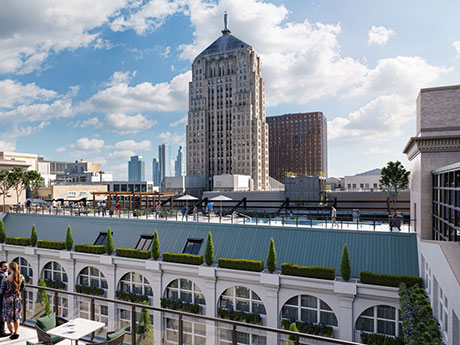By Trina Sandschafer, AIA, Project Management Advisors
Adaptation and reinvention are core parts of what makes American cities great, and Chicago is a prime example. Whether rebuilding, reimagining space for modern usage or creating new neighborhoods from formerly empty lots, the city has become known for its unique ability to bring new energy and life to formerly underutilized areas. Chicago knows how to reimagine the built environment and is leading the way with several transformative development strategies.
Adaptive reuse: A well-tested Chicago tactic
Chicago’s long history of adaptive reuse began with the pioneering residential loft developers. In the wake of nationwide manufacturing declines, these enterprising developers saw opportunity in the city’s largely vacant warehouses and manufacturing buildings. The success of these early loft conversions encouraged further reimagining of Chicago’s aging industrial and office stock into condominiums, apartments, offices, entertainment venues and hospitality spaces, which continue to this day.

Now, adaptive reuse strategies are helping to increase the supply of housing and restore economic viability to communities dealing with the lingering impact of the pandemic on local businesses. Converting legacy structures to new and better uses is more environmentally sustainable and can be more cost-effective than demolishing older buildings and starting fresh.
A premier example is the Fulton Market neighborhood. Over the last 20 years, the former meatpacking and warehouse district has been transformed into a vibrant destination for high-profile companies, top restaurants, hotels, apartments and condominiums. Fulton Market has been further enhanced with new streetscape improvements and ample public transportation access. Its proximity to the central business district (The Loop) is also a key factor in its success.
Bolstered by the successful revitalization of the West Loop, the City of Chicago released a visionary plan to reinvent the LaSalle Street corridor in November 2024. The plan approved nearly $250 million in tax-increment financing (TIF) to support the conversion of five office buildings into more than 1,400 units of mixed-income housing. From the earliest proposals, these units were supported with landscaping, outdoor plazas, creative lighting and active alleys to activate the area and turn it from a conventional financial district into a vibrant community-oriented neighborhood.
While many of the city’s adaptive reuse projects focus on much-needed residential space, others continue placemaking and activating areas that would otherwise be lost in the transition between more active neighborhoods. The Salt Shed, a former Morton Salt warehouse, is now a destination concert venue, generating economic activity along the Chicago River by drawing in local and regional visitors. In the Austin neighborhood, the new Aspire Center created a workforce training development facility out of a vacant elementary school building. Designed as a community anchor, the center aligns with the community’s economic development and youth empowerment programs, addressing critical quality of life issues through the built environment.
Despite the benefits of adaptive reuse, major challenges include lengthy development times, unpredictability and financing. Government incentives can be essential for helping a project move forward, and converting office buildings into affordable — or even attainable — housing requires creative financing and public investment to offset high construction costs.
Community-centric development
While breathing new life and purpose into older buildings is critical for urban renewal, adaptive reuse is only one strategy currently employed in Chicago to revitalize the city. Private development is a key factor in the ongoing investment into Chicago’s future. The owners of the United Center recently proposed a $7 billion project to redevelop the center’s 55-acre parking lot into a new neighborhood. The development would feature nearly 9,500 new housing units — including 2,000 affordable units — a parking structure, music hall, hotel, retail options and a rooftop park.
The 78, a full neighborhood concept in development at Roosevelt and Clark streets on the South branch of the Chicago River, is taking a former trainyard and building out a vibrant new mixed-use community. Once completed, The 78 is set to include more than 10,000 ground-up residential units, 20 percent of which are planned to be affordable housing, a new Red Line “L” station, office developments, dining and entertainment, and potentially new professional sports venues.
The PsiQuantum campus planned for Chicago’s Southeast side is another example of private development helping to bolster the city’s economy through the transformation of unused land. Once completed, the Palo Alto-based startup’s development of the former U.S. Steel South Works site is expected to bring more than 150 new jobs and at least $1 billion in investment in its first five years of operation.
The City of Chicago has also been expanding access to transit and modernizing transit stations to benefit communities. The L station at State and Lake streets is slated for a redesign to improve safety, access and shelter from the elements in The Loop. And a new Green Line L station at Damen Avenue and Lake Street has returned L access to the near West Side after a 77-year absence. The new stop is designed for safety and provides bike and bus lanes to connect community residents with long-needed mobility options.
What other cities can learn from Chicago
Chicago has many lessons to share on urban revitalization. While far from the only U.S. city pursuing adaptive reuse projects, transit-oriented development and community-centered projects, the city’s focus on reinvigorating neighborhoods such as Fulton Market, the Chicago Riverfront and The Loop show how these approaches can support one another and ultimately lead to greater economic resiliency.
Chicago’s most successful urban revitalization projects are those that pay close attention to market demand, neighborhood character and community engagement. Successful projects like the Aspire Center recognize neighborhood residents as the end users and prioritize early and frequent community engagement. Integrating vocational training, community resources and flexible public spaces in a mixed-use setting, Aspire Center was designed with ample input from local organizations to meet the specific needs of the city’s Austin neighborhood residents.
City of Chicago programs that support urban revitalization include zoning flexibility, Class L property tax incentives, TIF districts and historic preservation grants. City support is critical for realizing new potential in older buildings and underutilized neighborhoods.
With so many pioneering projects under its belt and yet to come, Chicago is prepared to employ creative urban renewal strategies into the future, making the most of the city’s unique properties and neighborhoods.
Trina Sandschafer, AIA, is vice president and managing director, Chicago, with Project Management Advisors. This article originally appeared in the March 2025 issue of Heartland Real Estate Business magazine.


